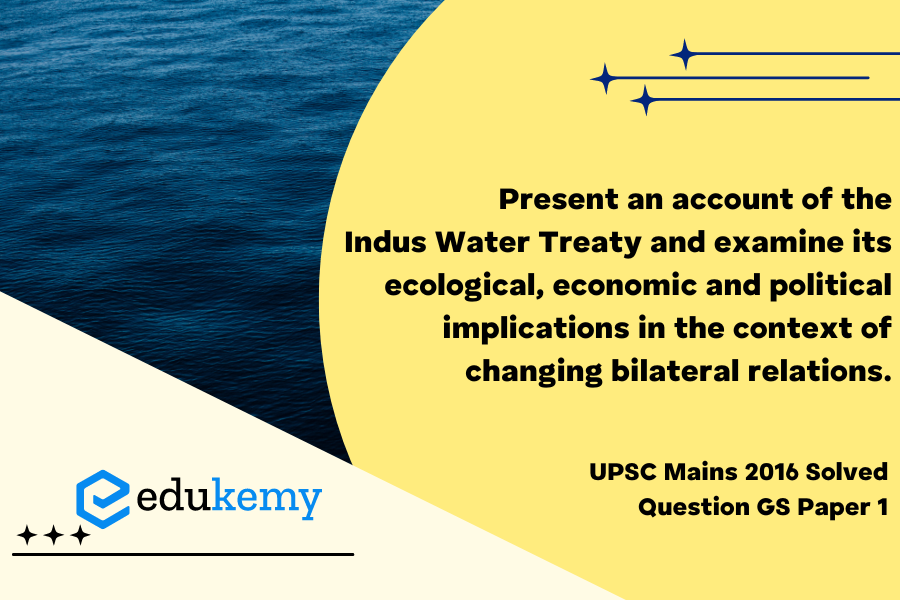The Indus Water Treaty (IWT), signed in 1960 between India and Pakistan, stands as a significant international agreement governing the sharing of water resources from the Indus River system. Facilitated by the World Bank, the treaty aimed to address water-related conflicts between the two neighboring nations. The treaty delineated the Indus River into eastern and western rivers, with India granted exclusive rights over the eastern rivers (Ravi, Beas, and Sutlej) and Pakistan over the western rivers (Indus, Jhelum, and Chenab). As both countries grapple with growing populations, expanding agriculture, and increasing industrialization, the IWT has become a focal point for examining the interplay of ecological, economic, and political factors. The ecological implications revolve around sustainable water management, ensuring the environmental health of the Indus basin. Economically, the treaty influences agricultural practices, hydroelectric power generation, and overall economic development. Politically, it remains a crucial aspect of bilateral relations, shaping the dynamics between India and Pakistan. In the context of evolving relations, the examination of the Indus Water Treaty sheds light on how shared resources can either be a source of cooperation or contention, reflecting the broader complexities in the diplomatic landscape of the Indian subcontinent.
Tag: Distribution of key natural resources across the world (including South Asia and the Indian sub-continent).
Contents
Decoding the Question:
- In Introduction, try to write a brief introduction of the Indus Water Treaty (IWT) and its components.
- In Body, elaborate separately, the IWT’s Ecological, Economic and Political implications in the context of changing bilateral relations:
- Conclude with the success of the Indus Water Treaty.
Answer:
Indus Water Treaty (IWT) is a transboundary water distribution agreement between India and Pakistan mediated by the World Bank on 19 September 1960. This treaty determined and delimited the rights and obligations of both countries regarding the use of the water of the Indus River system. It addressed the waters of the western rivers, i.e., the Indus, Jhelum, and Chenab, to Pakistan and those of the eastern rivers, the Ravi, Beas, and Sutlej, to India.

IWT’ Ecological, Economic and Political Implications in the Context of Changing Bilateral Relations:
Ecological Implications:
- Groundwater depletion: The IWT clearly lays out the rules for the use of surface water but groundwater management and governance are not addressed yet.
- The Indus Basin is the second most overstressed on the Earth, as indicated by a NASA survey. Groundwater levels have fallen dismally in Punjab, Rajasthan and Haryana.
- In Pakistan’s case too, they have developed the contiguous irrigation system to divert waters of the Indus Basin to its farms leading to depleted groundwater.
- Climate change:
- The Indus river system is said to have maximum dependence on glacial meltwater. In the short-term, increased temperatures and glacial retreat in the Himalayas could result in increased water availability, in the long run water availability is expected to plummet steeply.
- The construction of the small dams on the Indus river system will have devastating results as these dams are built on high seismic prone zones.
Economic Implications:
- Dependency on Agriculture:
- Both India and Pakistan, being agrarian economies, are heavily dependent on agriculture.
- The Indus river provides the key water resources for the economy of India and Pakistan, especially the breadbasket of Punjab province on both sides, which accounts for most of the nation’s agricultural production.
- Water Resources for Economic Activities:
- Many development projects like In India a number of dams, barrages, and link canals have been built to distribute water from the eastern Indus tributaries to the Punjab and neighbouring states.
- The Harike Barrage, at the confluence of the Beas and Sutlej, channels water into the Indira Gandhi Canal, which runs to the southwest to irrigate desert in western Rajasthan.
- The fast-growing populations and increasing demand for hydropower and irrigation in both India and Pakistan means the Indus is coming under intense pressure.
Political Implications:
- The Indus Water Treaty (IWT)
- India’s role as a responsible upper riparian abiding by the provisions of the treaty has been remarkable. The Indus Water treaty has remained “uninterrupted” because India regards its signatory and values transboundary rivers as an essential connector in the region in terms of both diplomacy and economic prosperity.
- There have been several instances of terror attacks originating and planned from Pakistan soil like Indian Parliament in 2001, Mumbai in 2008, the incidents in Uri in 2016 and Pulwama in 2019 which could have prompted India, within the Vienna Convention on the Law of Treaties, to withdraw from the IWT. However, on each occasion, India chose not to do so.
Indus Water Treaty is often cited as an example of the possibilities of peaceful coexistence that exist despite the troubled relationship. In fact, many Scholars, diplomats dub this treaty as “uninterrupted and uninterruptible”.
In case you still have your doubts, contact us on 9811333901.
For UPSC Prelims Resources, Click here
For Daily Updates and Study Material:
Join our Telegram Channel – Edukemy for IAS
- 1. Learn through Videos – here
- 2. Be Exam Ready by Practicing Daily MCQs – here
- 3. Daily Newsletter – Get all your Current Affairs Covered – here
- 4. Mains Answer Writing Practice – here


